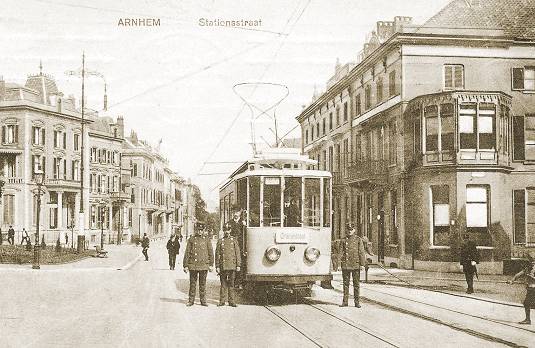

The town of Arnhem in central Holland is well known from WW2 when an allied assault on the area to liberate it from German occupation and open a second front (codenamed 'Market Garden') failed disastrously. The town (now city) of Arnhem is the capital of the province of Gelderland with a population today of around 160,000. Archaeological finds have shown human activity in the area from 70,000 years ago, but there is evidence of a settlement from around 1500BC. Fast forward to the 19th century and the town had become an inland resort.
A standard gauge horse tramway had opened in May 1880 under the Arnhemsche Tramweg Maatschappij (Arnhem Tramway Company or ATM) with two town routes and an out of town route to Velp in the east, with a route total of 12km. In August 1910, the municipality opened a short horse tram line between the station and Velperplein but on 1067mm (3 feet 6 inch) gauge. The 'Gemeente Electrische Tram Arnhem' (GETA) was formed in January 1911 and the ATM was taken over but their horse tram lines ran until June 1912. In the meantime, the first four electric lines were completed by the municipality, also on 1067mm gauge. For a relatively small town at the time, it built quite an extensive and well patronised route network. We all know the Dutch love of cycling but the town has one of those rare commodities in The Netherlands - hills! These no doubt contributed to tram patronage.
Although posted in 1916, our postcard shows tram number 1 in Stationstraat (the station is off to the left) on a test run, probably in early May 1911 before the system opened later in the month. The tram shows 'Oranjestraat' (to the west of the station) on the destination board but with no route number; it became route 1 upon opening. The tram also has a drop-down 'Voll' (Full) sign at the top of the windscreen, even though the tram is probably empty; it wasn't going to pick up any passengers yet. Characteristically, all Arnhem trams had double headlamps.
The tram was the first in the series 1-13, delivered in 1911 from the German builder Carl Weyer & Co. of Düsseldorf. These had two 26hp motors, three side windows and were painted in a cream livery. As delivered, they had no doors but these were fitted during WW1. Services were also operated with trailers which, in the early days, were provided by old horse trams.
The main route (Route 1), after extension from Oranjestraat, eventually ran to Oosterbeek in the west and out to Velp in the east and was, in part, of interurban character. Other more traditional tram routes negotiated some of the narrower streets of the old town centre and areas to the north. At Velp, there was a meeting with the 750mm gauge steam tramway of the 'Geldersche Stoomtramweg Maatschappij' (GSM) which was extended to Arnhem as late as 1926, a major business being freight. Arnhem was one of the very few town tramways in Holland to have sizeable goods traffic.
To the west from Arnhem, towards Oosterbeek, a steam tramway had been opened in May 1884 on 1067mm gauge by the Ooster Stoomtram Maatschappij (OSM); a line that ultimately reached Utrecht some 60km (40 miles) away. In 1912, the GETA route 1 was extended from Oranjestraat to Oosterbeek over the tracks of the OSM. During the 1920s, the electric tramway was extended to some new housing areas and new bogie cars were added to the fleet. It all came to an end in September 1944 as result of war damage.
Although the trams didn't make it through, electric traction came back to the streets after the war in the form of trolleybuses from 1949. The system runs to this day, now using modern articulated vehicles as the only trolleybus system in the country.
Even that is not the end of the 'electric story'. In 1993, a group of enthusiasts came up with a plan to build a replica Arnhem tram - one of the 1929 series 70-75. It was built as no.76 from the bogies of RET (Rotterdam) four-axle tram 530 and completed in 1998 with four 35hp motors but, importantly, on standard gauge and not on the Arnhem 1067mm gauge. This is because it can be run on any of the three present-day Dutch tramway systems which are all standard gauge. Another reason became apparent after the Netherlands Open Air Museum, in a northern district of Arnhem, opened a standard gauge circular tramway in 1996. The Arnhem replica now calls this museum home so can be seen and ridden on in the town.
![]() Go to Postcard Of The Month Index
Go to Postcard Of The Month Index